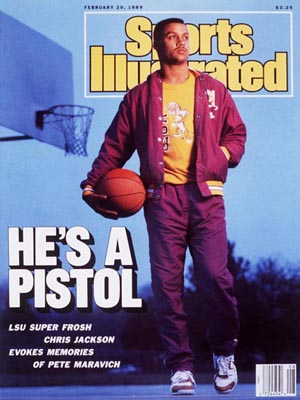Tiger Den Basketball Archives - I
Tiger Firsts: Basketball Team
January 30, 1909: LSU 35 Dixon Academy 20 @ Covington LA
| Edgar R. Wingard, who had been the Tiger football coach since 1907, organized the school's first men's basketball team in early 1909. Wingard had learned both games at Susquehanna College in PA. |
 |
- W. J. "Red" Phillips captained the squad and played G. Other players were F J. R. Keeny, F L. R. Lesher, C B. B. Johnson, G J. A. Larcade, and sub J. Y. Sanders Jr.
- Surprisingly, none of these players was a gridder for Wingard.
The first game was played at Dixon Academy in Covington LA.
- The privately-owned school had been founded in 1907 and was considered to have a "crack" team that won the state championship (whatever that meant) two years in a row.
- However, LSU won easily 35-20, the result being characterized by The New Advocate of Baton Rouge as "quite a surprise to admirers of the local team [LSU]."
- The Tigers adjusted to playing indoors after doing all their practicing outdoors. Keeny led all scorers with eight goals.
Dixon Academy, having failed to attract enough students, was sold to the Benedictines of nearby St. Joseph Abbey. The monks reopened the school in 1911 as St. Paul's. The following year, Christian Brothers from France purchased the property and still operate St. Paul's High School today.
The 1909 Tigers ended with a winning record.
- They won a two-game home series over Mississippi A&M 18-12 and 14-10. (A&M became Mississippi State.)
- A 36-14 shellacking of Baton Rouge High brought the winning streak to four.
- Presumably, all these home games were played outdoors as the campus had no gymnasium.
- A two-game series in New Orleans against the YMCA produced 27-11 and 37-16 defeats on back-to-back nights.
- Wingard's team completed its maiden season with a 21-12 triumph over Dixon in a return engagement in BR.
- Final tally for Wingard's only season at the helm: 5 wins, 2 losses overall and 2-0 in conference.
The 1909 Gumbo, the LSU yearbook, reported that the women's basketball team was "only defeated once."
|
|
Snapshot: LSU National Champs
In 1935, there was no NCAA tournament (first one 1939) or NIT (1938). There wasn't even an AP poll (1948-9).
- The ultimate in college basketball was the conference championship – determined either by regular season play or a post-season tournament.
- However, LSU got an opportunity to claim a "national championship" when it was invited to play in the "American Legion Bowl" in Atlantic City, NJ,
against the Pittsburgh Panthers.

LSU 1935 National Champions |
LSU finished its season 14-1.
- The only loss was to Rice in Houston, 56-47. The Tigers'
Sparky Wade later said:
The Rice Gym was an old auditorium with one chandelier with twenty-five watt bulbs. You could not see your feet or the color of uniforms. Even the floor was unwaxed.
- The Rice game was one of only three games away from Baton Rouge and the only one not in Louisiana, since the other two away games were at Tulane in a two-night series in February – a common scheduling ploy in those days.
- LSU hosted two-nights-in-a-row
games against Alabama, Ole Miss, Mississippi State, Vanderbilt,
and Tulane.
Notice the major missing conference opponent: the Kentucky Wildcats.
- Adolph Rupp's squad was 11-0
in SEC play.
- LSU claimed the
crown with a 12-0 record since the post-season conference tournament was
not held that year.
- In its media guide, Kentucky claims to be the 1935 SEC "Co-Champions." LSU's
publication says simply "SEC Champions."
- Scores against common
opponents favor Kentucky.
|
LSU was led by a 5'8" dynamo named Sparky Wade (#23).
- Sparky was a forerunner of Pete Maravich in Baton
Rouge.
- Harry Rabenhorst, who coached LSU from 1925-1957, said in 1951 that Wade was his greatest player.
(This was just before Bob Pettit arrived.)
We've had some great ones, but Sparky Wade was the most spectacular and
most colorful. He was a showman and probably the greatest dribbler in basketball.
- The pride of Jena LA, Wade is a member of the LSU Sports Hall
of Fame.
At any rate, LSU met Pittsburgh on April 13, 1935, before 5,000 fans in the Atlantic City Auditorium.
- Doc
Carlson's 18-5 Panthersdid a good job of curtailing Wade's scoring, holding him to five points. They jumped out 18-4 and led 26-17 at the half.
- Buddy Blair (top row, far right in picture above) explained the Tigers' problem.
Pittsburgh used a figure-eight offense. We had not seen this before and it hindered
us in the first half. In the second half, we got our fast break going and just
about ran them crazy.
- The Tigers roared back to win, 41-37. Blair led all scorers with 20 points.
|
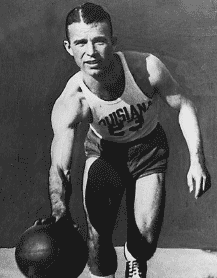
Sparky Wade |
Here's the text of the Associated Press article on the game.
Atlantic City, N. J. April 13. (AP) — Louisiana State university, power in the Southeastern conference, came from far behind tonight to defeat the University of Pittsburgh, eastern conference champions, 41 to 37, in their intersectional basketball game.
The Bayou Tigers from Baton Rouge, trailing 26-17 at the half, smothered Pittsburgh in the second period with their flashy passing and scored goal after goal from the field.
Buddy Blair, Louisiana's sharpshooting forward, tallied nine field goals and two fouls to score nearly
half of the Tigers' points.
Noon, Pittsburgh's lanky center, led the Panthers for scoring honors
with five field goals and two fouls. Cribbs, Panther guard, also made five goals.
The game was played in the Atlantic City auditorium before a crowd of 6,000.
To this day, LSU proclaims this
team as "1935 Mythical National Champions." Take that, Kentucky!
|

Joe Adcock
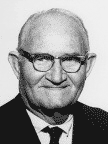
Harry Rabenhorst |
Joe Bill Adcock lettered in basketball at LSU from 1944-47.
- He made the all-SEC tournament second team at C in 1946 (when the all-tournament team was the all-SEC team as well).
- If the name sounds familiar but you can't quite place it, think baseball, not basketball.
- Joe Adcock had a 17-year major league career, primarily with the Milwaukee Braves.
- He is one of only 15 men to hit four HRs in a single MLB game. Joe did it in 1954 at Ebbets Field in Brooklyn.
- He also stands as the first of only three players to homer into the CF bleachers at the Polo Grounds in New York.
Born in Coushatta LA 10/30/1927, the 6'4" Adcock played for four different basketball coaches at LSU in his four years as a result of the adjustments necessitated by World War II.
1943-44
- The Tigers were 10-15 under coach Dale Morey, in his second year after replacing Harry Rabenhorst, who had coached since 1925 before entering the military in 1942. Morey is the only coach to go straight from playing for to coaching LSU.
- Adcock lettered as a 16-year old freshman, one of a multitude of sports anomalies caused by WWII.
- The Tigers played only four SEC games, all against Tulane, and lost them all. Kentucky defeated LSU 55-28 in the first round of the SEC tournament in Louisville as the Wildcats won their first of seven straight tournament championships.
1944-45
- 15-9 under Jesse Fatherree and then A. L. Swanson.
- Because of wartime travel restrictions, LSU played only six conference games, splitting two with Mississippi State and four with Tulane.
- UK again clobbered the Tigers to open the SEC tournament, 63-37.
1945-46
- With Rabenhorst back in charge, LSU went 18-3 overall and 8-0 in the conference.
- They swept home-and-home series with Mississippi State, Ole Miss, Alabama, and Tulane.
- Adcock led the SEC in scoring with an 18.6 average.
- In the tournament at Louisville, the Tigers ripped off three wins over Tulane 74-29 as Adcock set a tournament record with 31 points, Ole Miss 69-34, and Georgia 60-41 to reach the finals against Kentucky.
- The Georgia win was impressive because Adcock and two other regulars had been stricken by food poisoning the night before but played the next afternoon anyway.
- But they were no match that evening for the Wildcats, losing 59-36 before a capacity, partisan crowd of 6,000. Adcock led all Tiger scorers with 11.
- His illness probably cost Joe a spot on the All-Tournament first team, although it would seem that his 31-point outburst should have secured him a spot.
- Since only the conference champion entered the NCAA tournament and the NIT didn't invite the Tigers despite their sterling record, LSU's season was over.
1946-47
- 17-4 overall and 8-2 in the SEC
- The Tigers entered the SEC tournament on a roll with eight straight victories starting and ending with the Loyola Wolfpack sandwiched around six league wins in between.
- LSU downed Ole Miss 61-36 and Florida 60-45. However, in the semifinals, Tulane, which had lost two of three to the Tigers in the regular season, derailed LSU 63-50.
Adcock is listed as a letterman only for 1947 in the LSU Baseball Media Guide.
- Apparently, Rabenhorst, who was also the baseball coach, got him on the diamond team only in his senior year.
- That was enough to impress the Cincinnati Reds who signed him to a minor league contract. He played OF and 1B for the Reds from 1950-2.
- Traded to Milwaukee for the 1953 season, Joe had ten productive years with the Braves, including World Series appearances in 1957-8.
- In 1956, he slugged 38 HR and drove in 103, second in the league in each category.
- He had another outstanding season in 1961 with 35 HR and 108 RBI.
- He played his last four seasons in the AL with Cleveland and California.
- Joe rapped 337 career four-baggers.
- He managed the Indians to an eighth-place finish in 1967.
LSU inducted Adcock into its Sports Hall of Fame in 1978.
- For the celebration of the centennial of LSU basketball in 2009, Joe was voted to the All-Decade Team of the 1940s.
- He died in 1999 in Coushatta at age 71.
|
|
Memorable Game: Pistol vs UCLA
"Bruins Fire 133-84 Cannon at LSU; Pistol Misfires – Nets 'Only' 38"
That was the metaphor-filled headline in the Long Beach Independent on December 24, 1969, the day after LSU played #2 UCLA before the largest crowd to that point in Pauley Pavilion history, 12,961. The 133 points was a school record for the Bruins, breaking the 129 mark they had set just two weeks earlier against Miami of Florida.
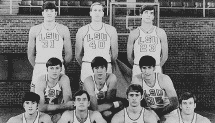 1969-70 LSU Tigers
1969-70 LSU Tigers
Front row: Tom Hess, Jeff Tribbett, Tom Henner, Rich Hickman
Middle: Kent Johnson, Bill Newton, Danny Hester
Rear: Al Sanders, Bob Lang, Pete Maravich |
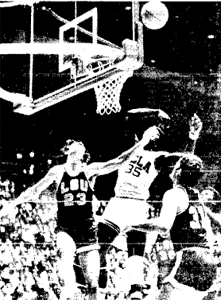
SORRY ABOUT THAT
LSU's Pete Maravich, trying to rebound under basket, accidentally whacks UCLA's Sidney Wicks in face in game in Pauley Pavilion |
Afterwards, both coaches acknowledged the weariness of the Tigers, who were playing their fourth game in six nights. After losing to USC at home 101-98 on the 18th, LSU hit the road, defeating Clemson 111-103 and Oregon State 76-68 before invading L.A. After the game, the Bengals flew to Hawaii for the Rainbow Classic.
UCLA jumped out 9-0 in the first few minutes and raced to a 69-40 halftime lead. Determined to stop the nation's leading scorer for the past two years, John Wooden sent two defenders at Maravich every time he turned his back while dribbling, stealing the ball several times and forcing him to pass off. Pete missed 10 of his first 11 shots. His 38 points were his lowest total for the season to date. The Long Beach reporter wrote: "Maravich drew occasional oohs and aahs with his distance jumpers and wrap-around passes."
Pete generously praised the victors. "They ought to join the NBA. They'd fit right in. Honestly, everybody they have is good." Pete added, however: "I was dead tired."
Curtis Rowe and Sidney Wicks shared scoring honors for the home team with 23. Steve Patterson pulled down 17 boards. Danny Hester contributed 22 points for the Tigers.
|
Snapshot: Eddie Palubinskas
 Eddie Palubinskas
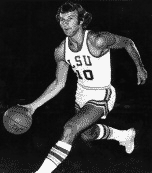
Palubinskas in Action
|
Eddie Palubinskas from Canberra, Australia, played at LSU from 1972-4 for new coach Dale Brown after playing two seasons at Ricks Junior College in Idaho where he made JC All-American. He was drafted by the Atlanta Hawks in 1975 in the third round and also in the eighth round by the Utah Stars of the ABA.
Considered one of the best basketball players in Australian history, Palubinskas played for his native country in both the 1972 and 1976 Summer Olympics. He set three Olympic scoring records in Montreal in 1976, including the most points scored in a single Olympics (269), a mark that lasted until 1988 when Brazilian Oscar Schmidt broke it.
Palunbinskas is in the LSU Record Book in several categories.
- 31 consecutive FTs made over two seasons in 1973-4
- FT% in a game (minimum 15 attempts): 15-15 vs Mississippi State 3-1-73
- Career FT%: .875 (259-295) 1972-4
Eddie averaged 18.5 ppg for his career, good for eighth on LSU's all-time list.
- He led the Tigers in assists in both 1973 and 1974.
- His top point production in a game was 32, which he tallied twice (MemphisState 12-5-72 and Florida 2-9-74). He also put up 30 against Nevada-Reno (12-3-73). He made the All-SEC second team of both the AP and UPI in 1972-3. The next season, he was second team all-conference for the AP and third team UPI.
With all that said, Palubinskas is more well known to Tiger fans as the FT-shooting guru who has worked with Shaquille O'Neal among many others. It took a serious accident to send Eddie down that road. Seven years after leaving LSU, while he was coaching high school basketball in Utah, his car skidded on an icy patch. The crash shattered the right side of his body, including his shooting arm, which had a compound fracture.
While rehabbing, Eddie analyzed FT shooting in order to decide how a player could get closer to 100% from the line. Starting in his hospital bed, then in a wheelchair beneath the basket, and finally on his feet at the line, he experimented with such variables as the spread of his fingers on the ball, the orientation of the grain, and the alignment of his elbow. He concluded that the most likely reason for a missed FT is lateral movement of joints or muscles that causes a deviation from a straight line.
Eddie became a college assistant at BYU from 1986-9. He coached under Dale Brown in Baton Rouge in 1991-2, an SEC championship year. While an assistant with the Los Angeles Lakers in 2000-1, Eddie worked with Shaq to improve his FT% and became the Big Aristotle's personal FT coach. O'Neal improved from 51.3% that year to 55.5% the next season and then a career-high 62.3% in 2002-3.
Palubinskas, who founded the Palubinskas Basketball Academy in 1996 to teach shooting fundamentals to basketball players of all levels, was featured in an article on FT shooting problems in the NCAA Tournament in the 3/23/2009 issue of Sports Illustrated.
|
|
Dazzling Debut: Chris Jackson
|
|
The 1988-9 Tigers opened SEC play unusually early.
- On December 10, LSU invaded Gainesville to play the Florida Gators on ESPN.
- After four home games, Dale Brown's squad was only 2-2 with victories over Marist (94-58) and McNeese State (91-89) sandwiched around losses to Oral Roberts (96-100) and Louisiana Tech (109-111 in OT).
- LSU was led by freshman sensation Chris Jackson from Gulfport MS, fresh off a 48-point outing against Tech.
In arguably the greatest conference debut in SEC history, Jackson poured in 53 points to lead the Tigers to a 111-101 triumph.
- He thus broke Pete Maravich record for most points ever scored by an opposing player against Florida. Pete had torched the Gators for 52 in 1970.
- Jackson's point total was also the most by a freshman in NCAA history.
- Chris scored 15 in the final seven minutes to hold off a Florida rally.
Afterwards, Brown praised Jackson's "magnificent feel" for the game and admitted he was overcoaching CJ until midway through the game.
- After Chris spent several minutes passing off, Dale called a TO to tell him to fire away.
- Jackson: "I want to get everyone involved. I feel funny taking so many shots." His brief shooting hiatus may have cost him a 70-point game.
Jackson was part of one of the most highly regarded recruiting classes in the nation. However, three members – 6'11" Stanley Roberts, 6'8" Harold Boudreaux, and 6' Maurice Williamson – had to sit out the season because of NCAA's Proposition 48 which mandated a minimum ACT score adjusted for the player's GPA.
It is remarkable that Jackson played college basketball at all.
- He doesn't know who his father is and was somewhat estranged from his mother because she opposed his enrolling at LSU.
- Also, he suffered from Tourette syndrome, a neurochemical disorder that results in uncontrollable moans and cursing, arm/hand flapping, and spasmodic twitching and blinking.
At Gulfport High, where he was two-time Mississippi Player of the Year, Jackson once made 283 FTs in a row.
Chris went on to average 30.2 for the 1988-9 season, which is still the highest ever by a freshman. So he helps give LSU a unique distinction: Tigers hold the four records for highest ppg by a freshman, sophomore, junior, and senior in NCAA history. Of course, Pistol Pete holds the other three marks since freshmen were ineligible when he arrived in Baton Rouge and players could not leave college early for the NBA. |

Harry Rabenhorst
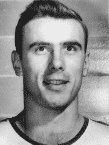
Bob Pettit

Don Schlundt
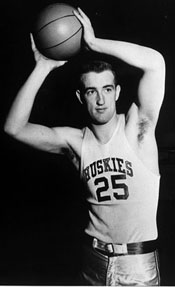
Bob Houbregs |
Led by All-American junior Bob Pettit, LSU played in its first Final Four in 1953. Coach Harry Rabenhorst's Tigers usually started this five.
- F Don Belcher
- F Ned Clark
- C Bob Pettit
- G Benny McArdle
- G Norm Magee
The Tigers romped through the SEC with a 13-0 record.
- Kentucky did not field a team that season because of a point-shaving scandal.
- LSU's only regular season loss came at Tulsa on December 22, 84-58.
- The Tigers bounced back from that defeat to win the Sugar Bowl Classic, defeating Villanova 100-94 and St. Louis 70-67.
As SEC champion, LSU received a bye in the first round of the NCAA tournament. They played Lebanon Valley, which had upended Fordham 80-67, in Raleigh NC.
Big, Rough Tiger Five Halts Flying Dutchmen
- That was the headline in the Lebanon (PA) Daily News on March 14, 1953.
- "6'9" giant" Pettit scored 28 while Magee threw in 23.
- LSU led 49-43 at the half and only 63-58 after three periods. However, a 26-18 Q4 salted away the 89-76 victory.
The Holy Cross Crusaders provided the opposition in the regional final the next night.
- The Tigers forged an 18-point lead in Q3, then held off a late HC rally to prevail 81-73.
- Pettit led all scorers with 20. The Tiger D held high-scoring F Togo Palazzi to eight points.
- With LSU ahead 66-46 early in Q4, McArdle and Clark fouled out. HC capitalized to pull to 72-67 with four minutes left on Palazzi's only FG of the game. However, the Tigers added a FT and two FGs in quick succession to ice the contest.
The following week, LSU traveled to Kansas City to meet the Indiana Hoosiers in the national semifinals.
- Pettit's 29 matched the total of IU's Don Schlundt, but Bob Leonard tossed in 22 for the Big Ten champs, who led after every quarter on their way to an 80-67 victory.
- Magee scored 17 and Belcher 10 for the Tigers.
In those days, the semifinal losers played a consolation game for third place.
- Bob Houbregs, 6'8" C for Washington who would be named NCAA Player of the Year, poured in 42 to outduel Pettit by 9 in the Huskies' 86-69 triumph.
- LSU thus started a streak of Final Four losses that persists to this day – LSU has never won a game at the Final Four in either men's or women's basketball.
P.S. LSU also lost the last third-place game at the Final Four. In 1981, on the day that President Reagan was shot, Virginia won 78-74 in Philadelphia after Dale Brown's Tigers had fallen to Indiana 67-49.
P.S.S. Pettit, Belcher, Clark, and McArdle all made the LSU Team of the Decade for the 1950s in fan voting in 2009 for the centennial of Tiger basketball.
|
Interesting Story: Dale Brown Takes Over – I
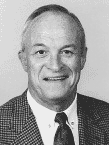
Dale Brown
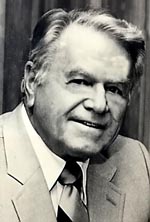
Carl Maddox
|
Dale Brown first met Joe Dean in 1971 while Dale was an assistant at Utah State.
- Somewhat disenchanted with coaching, Dale was contemplating working for Converse, where Dean was an executive.
- Joe encouraged Dale to get out in the field and network to make himself better known in his profession.
In January 1972, after Brown had moved to Washington State as an assistant, Carl Maddox, the LSU AD, called him.
- Maddox had decided it was time to replace Press Maravich, and Dean had recommended Dale as one of five coaches Carl should talk to.
- Maddox met with Dale for three hours and then invited him to speak to the selection committee.
- When Dale called his wife Vonnie to report on the meeting, she told him, "You should have joined the Japanese Air Force. You have a better chance of being a kamikaze pilot than getting that job."
- Dale replied, "Not this job. A kamikaze pilot has a brighter future than past coaches at LSU."
- The Tigers had had only one winning season in the last 13 – Pete Maravich's senior year – and only four in the last 18.
Several weeks later, Maddox invited Brown and his wife to Baton Rouge.
- In the meantime, Dale had been offered the head job at Washington State. He had told the WSU AD that he wouldn't accept the LSU job until he talked to him again.
- But after the second meeting with the LSU selection committee, Brown was told he had the job. He then told his AD that he and Vonnie loved it at LSU, and he was taking the job.
- The salary? $23,000 a year plus $25,000 for two full-time assistants and $2,400 for a graduate assistant.
Reference: Dale Brown's Memoirs from LSU Basketball |
Interesting Story: Dale Brown Takes Over – II
Joe Dean (who was not yet the AD) had warned Dale Brown about the challenges of the LSU job.
The people just aren't interested. You'll have to hang your nets, sweep the floor, keep your own stats and sing the national anthem.
Dale quickly saw why LSU was known as a football school despite the fact that the Assembly Center (" Pete's Palace") was only a year old.
- If a rim was broken or there was a water leak on the floor, Dale would report it but, tired of waiting, eventually got it fixed himself.
- The media guides were never out on time.
- Little was published about basketball in the local papers until football season ended.
- The team traveled to road games in a yellow school bus. The football team rode Greyhound busses just to go to the movies the night before a home game.
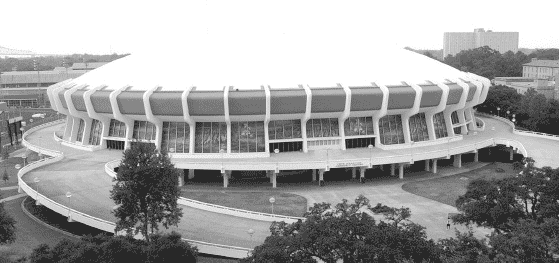
Instead of pouting, Dale got to work.
- He traversed the state. Wherever he saw a basketball goal, he stopped and introduced himself as the new coach at LSU.
- Brown gave out purple and gold nets that he paid for himself.
- He distributed coin purses with a picture of the staff and the schedule on it.
- Dale gave bibs to newborn boys at hospitals. They read: "LSU basketball welcomes you to the world."
Dale knew he was in trouble when the returning LSU lettermen lost to Catholic High in a practice game before fall practice began. So it was no surprise when the writers picked LSU to finish last in the SEC. Continued below ...
Reference: Dale Brown's Memoirs from LSU Basketball
Dazzling Debut: Dale Brown Takes Over – III
Brown's first Tiger team in 1972-73 didn't have an auspicious preseason. Coming off a 10-16 season the year before and not expected by any pundit to do well, the team lost to University of the Americas in Mexico 87-83. However, the next night they won the second game against the same team, 69-57.
The first official game brought #11 Memphis State to Baton Rouge. The night before the game, Dale introduced himself to Gene Bartow, the veteran coach of the visiting Tigers. Not sure what to say, Brown told Gene to let him know if he needed anything. Bartow replied, "Dave, I really appreciate you coming down. That was nice of you." Brown thought to himself, "You just wrote my speech for the players."
Inspired by "Dave's" pregame talk about getting no respect from the opponent, the outmanned Tigers were all over the court, diving on the floor and out of bounds, scrapping on every play. LSU led 44-22 at the half and won 94-81. JC transfer Eddie Palubinskas, one of four new starters for the Tigers, scored 32 before fouling out. Larry Finch's 24 led Memphis State, which would finish the season with a loss to UCLA in the NCAA Final.
Brown's first team, who came to be known as "The Hustlers," won 14 and lost 10 for the season, including a 9-9 SEC record. The Tigers won nine of their last 11 games. |

Eddie Palubinskas Top of Page |
|
CONTENTS
Tiger Firsts: Basketball Team
Snapshot: LSU National Champs
Snapshot: Joe Adcock
Memorable Game: Pistol vs UCLA
Snapshot: Eddie Palubinskas
Dazzling Debut: Chris Jackson
Tiger Firsts: Final Four
Interesting Story: Dale Brown Takes Over – I
Interesting Story: Dale Brown Takes Over – II
Dazzling Debut: Dale Brown Takes Over – III
Tiger Den Archives – II
Tiger Den Archives – III
Tiger Den Archives – IV
Tiger Den Archives – V
Tiger Den Archives – VI
Tiger Den Archives – VII:
2005-06 Season
Tiger Den Archives - VIII:
Pete Maravich's Career at LSU
Basketball Magazine
Golden Rankings Home
Top of Page
|


